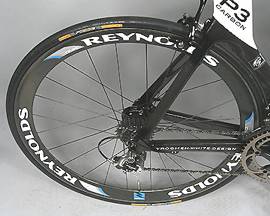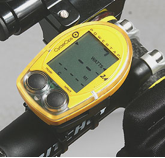 | ||||
Simplify Your Life on Race Day
Up until a few months ago I trained on clincher wheels and raced on tubulars. For those of you new to the sport, clincher wheels are standard and have a tube inside a tire mounted on the rim be a “bead” or seam that catches or an edge inside the rim. A tubular tire has no tube and is glued to a concave rim. When properly glued the glue and air pressure of the tire hold the tubular on the rim. Tubular tires offers some advantages such as being slightly lighter and have less rolling resistance, but recent advances in clincher tire and wheel technology have narrowed the performance gap and made me question if tubulars are worth the extra hassle. Here are some things you need to think about if you are considering tubulars for your race wheels. First, let’s assume that well before your big race you had the tubular tire stretched and glued correctly. This important task takes experience, strength and patience. And now imagine on race day you open your trunk and the tire is flat! Since a tubular tire needs at least 12 hours for the glue to dry properly you can’t simply change the tire right before the race even if you had the time. This means you have to bring a spare set of clincher wheels to the race… just in case. What if you qualified for IM Hawaii? You have to pack your bike in a travel box that will only fit one set of wheels. Do you really want to carry an extra wheel box, the bike box and all of your other gear? And what if you get a flat with your tubular during the race? Then pre race you have to remember to swap your clincher “flat pack” with a pre-stretched tubular and inflator. And keep in mind that if you change the flat during the race there is no glue on the tire and that you must take it very easy cornering, accelerating and braking. OK, OK got that, but what if your race is 112 miles and you have bad luck and get two flats? Then your day is over and all of your training and investment in the race is wasted. This happened to Norman Stadler in Hawaii IM 2005. There have been some great advances in clincher tire and wheel technology. Here is my current hot set up. I use a Reynolds DV46 C clincher wheel-set. The wheels feature a lightweight all carbon clincher aero rim (no aluminum braking track) that is 46mm deep. Reynolds has been selling the carbon clincher technology for 4 years and it really works. In fact the rim is so strong I use it all the time on my tri bike for both training and racing. For longevity and excellent braking modulation, Reynolds adds a special braking surface on the rim and include the excellent SwissStop yellow brake pads which have been formulated to work with carbon rims. For tires I have had excellent results with Continental’s Attack / Force combo. The tires grip great and are fast. The front tire called the Attack is a little narrower which is good for time trials or triathlons. The Force rear tire is wider and has extra rubber for better wear. Again, I train on these and have had great long term durability. One nice side benefit of racing with my “training wheels” is that I am totally used to how they corner and brake and this gives me more confidence on race day when the conditions are totally beyond my control. Another benefit is that there is less potential for wheel swapping mechanical issues. Such as having to change to carbon compatible brake pads or adjusting where the pads contact the rim, or even making sure that there are no shifting issues. Since these are wheels I ride everyday I have everything sorted out and there are no surprises. And for what it’s worth I have a saying…“training is training and racing is racing.” So for sure it’s good to train with power, but you are missing a big part of the puzzle if you don’t track what happens when you are really digging deep in a race. The race data will provide valuable information that can be used to determine future training intervals. And in the heat of battle, during a race, it is really nice to have an objective benchmark of how hard you are working as the competition, conditions and emotions can really skew your perception of effort. In conclusion tubular wheels have their place in short sprint to Olympic distance races where you chance of placing is over if you flat. But for longer multi-sport races the latest generation of aero clinchers, such as Reynolds DV46 C, offer an excellent solution (also check out the SDV66 C which will be available Nov. 2008). Racing with my everyday Reynolds DV46 clincher wheels has simplified my life on race day. And this lets me get down to business, center myself and focus on the race! Note: Bethel Cycle has Reynolds, Zipp and Powertap wheels in our demo fleet available for testing and weekend rentals. For more info email greg@bethelcycle.com or call 203 792-4640 . |
||||
 |
 design by cyberpunk@mac.com | © hodska.com 1999-2008 | images © EH Fitness and Training | contact us design by cyberpunk@mac.com | © hodska.com 1999-2008 | images © EH Fitness and Training | contact us |
 As a triathlete
As a triathlete 